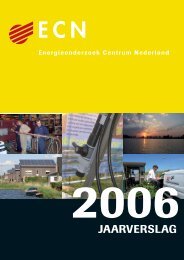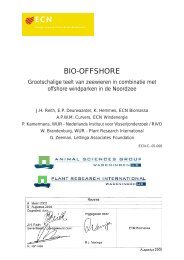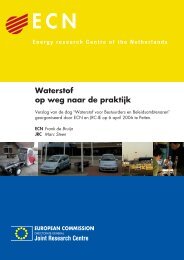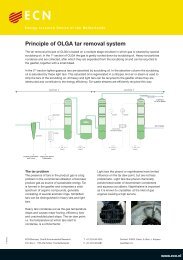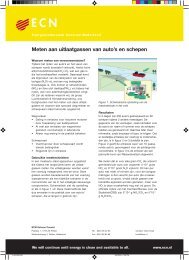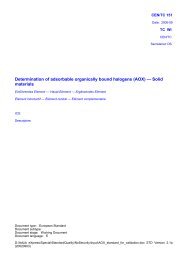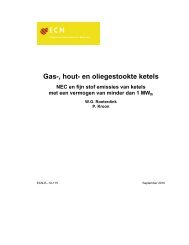PDF format (503 kB) - ECN
PDF format (503 kB) - ECN
PDF format (503 kB) - ECN
Create successful ePaper yourself
Turn your PDF publications into a flip-book with our unique Google optimized e-Paper software.
Table 1 The relevance of materials for GHG emissions, end use based system boundaries, based on actual<br />
emissions according to IPCC accounting guidelines<br />
CO2 Non-CO2 GHG Total Fraction<br />
[Mt CO2 equiv.pa] [Mt CO2 equiv.pa] [Mt CO2 equiv.pa] [%]<br />
Metals 244 11 255 26<br />
Synthetic organic<br />
materials<br />
167 53 220 22<br />
Natural organic materials 93 130 223 22<br />
Inorganic materials 49 60 109 11<br />
Ceramic materials 191 - 191 19<br />
Total 744 254 998 100<br />
The flows of energy and materials through the economy can be analysed in a systems approach. “A system is a<br />
structured assemblage of elements and subsystems, which interact through interfaces. The interaction occurs<br />
between system elements and between the system and its environment. The element and their interactions constitute<br />
a total system, which satisfies functional, operational and physical characteristics, as defined by the user<br />
and customer needs and requirements, over a defined total system life cycle of the system in existence, including<br />
the life cycle of bringing the system into being” [3]<br />
The system elements in the economy are called processes. They are defined by their energy and material inputs<br />
and outputs, by their emissions and by their costs. Examples are a blast furnace (input coal and coke, output<br />
liquid iron), a car manufacturing plant (input steel sheet, other materials and energy, output cars), landfill sites<br />
(input waste materials). The interfaces between the processes are called flows. They include energy flows and<br />
material flows. The function of the system is to satisfy a demand from the final users (e.g. a demand for housing,<br />
transportation, lighting and packaging). Constraints are for example added for the availability of resources,<br />
for the social acceptance of processes (like nuclear power plants or public transportation) and for the environmental<br />
impact of the system (like GHG emissions).<br />
How long is the life cycle of the system ? The definition encompasses all steps from the early system conception<br />
to its final abolishment. For the economy as a whole, it is difficult to set these boundaries. From a systems engineering<br />
point of view for GHG emission reduction, it is more relevant to analyze the system dynamics: how<br />
much time is required to achieve significant changes in the system configuration in order to change its environmental<br />
impact.<br />
The dynamics of the energy and materials system are defined by the rate of technological change, the turn-over<br />
rate of production processes, and the product life. The rate of technological change is often overestimated.<br />
Technological breakthroughs require decades, even if the development is successful. Many key processes in the<br />
energy and materials system show little technological change over the last century. Examples are blast furnaces,<br />
Hall-Heroult smelters for aluminium production, pulp mills, ignition engines for e.g. passenger cars.<br />
Gradual efficiency improvements have occured, but the technical basic principle has not changed. Development<br />
of alternatives was not succesful because of technological problems or because of worse process economics.<br />
Even if technology development is successful, the actual introduction is hampered by the slow diffusion processes<br />
for new technology. Literature data suggest the the time required for a new process to unfold from 10% to<br />
90% of the market share ranges from one decade to several centuries, depending on the pervasiveness of the<br />
technology and the interaction with existing practices and technologies [4]. Diffusion of new technologies is<br />
also hampered by the life span of existing capital equipment. The life span of industrial equipment ranges from<br />
1 to 5 decades. The life span of infrastructure ranges from 5 to 10 decades.<br />
Data for materials production suggest similar slow system dynamics. Figure 3 shows the materials production<br />
trends for a number of “old” materials (steel, cement) and “new” materials (polyethylene, aluminium). It is interesting<br />
to see the strong growth of paper production, despite the fact that this is the material with the longest




